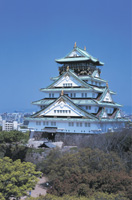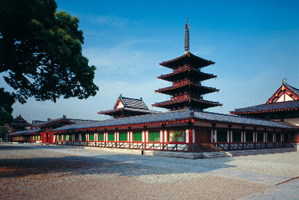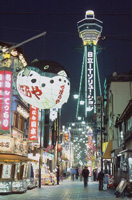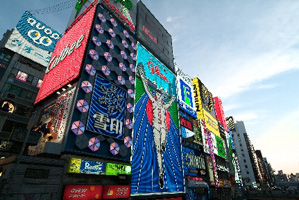|
| PATRONS |
| Platinum Patrons |
 |
| Gold Patrons |

 |
| Silver Patrons |
 |
| Bronze Patrons |


 |
| SUPPORTERS |




 |
|
 |
 - Osaka Castle
Osaka Castle, which is a famous landmark, a popular sightseeing spot, and the symbol of Osaka, contains thirteen structures which have been designated as Important Cultural Assets by the Japanese government. Of special note are the grand gates and turrets along the outer moat. The steep walls that rise close to 30 meters high are made of huge blocks of stone that were transported to Osaka from quarries over 100 kilometers away. The sheer height of the walls and the wide moats they rise above make for a grand sight that can be matched by no other castle in Japan.
Also of interest are the towe's eight roof dolphins and the ornamental roof tiles and reliefs carved in the shape of tigers, all of which are gilded with gold. |  |
- Shitennoji Temple
The oldest officially administered temple in Japan, Shitennoji was built by Prince Shotoku, the great cultural hero of early Japanese history who at the age of sixteen successfully triumphed over the opposition and brought about the adoption of Buddhism in the country.
Shitennoji is the favorite shrine of many Japanese people and is fondly regarded as the Buddhist altar of Osaka. Indicative of the temple's long history are the many annual events held here, including the Doya-Doya, the Shoryoe, and the Shitennoji Wasso. |  |
- Tsutenkaku Tower
The Tsutenkaku is a new structure, rebuilt after World War II. The original Tsutenkaku was built in 1912, and it shocked the people of that era; with a height of 64 meters, it was the tallest structure in the Orient. It was also one of the two great attractions of Shin-Sekai at that time, the other being Luna Park, an amusement park with an area of more that 132,000 square meters. Eventually the Tsutenkaku, which remind local residents of the Eiffel Tower in Paris, became the symbol of Osaka. But then in 1943 a fire broke out in the tower, and it was later dismantled to supply steel to the wartime economy. After various difficulties were overcome, the long-awaited new Tsutenkaku was erected in 1956. |  |
- Dotombori
Dotombori has so many restaurants and bars packed along its narrow streets and alleys that it's impossible to count them. Their colorful signs and decorated entrances create a symphony of light and design that dazzle the eye. It's here that visitors will find a huge mechanical crab, a giant blowfish and a drum-playing mannequin, just a few of the more intriguing signs that restaurants in Dotombori sport. Here is where visitors can experience the true meaning of "kuidaore" and stuff themselves with Osaka's great tasting, reasonably priced food to their ultimate culinary satisfaction. |  |
|
|  |
|